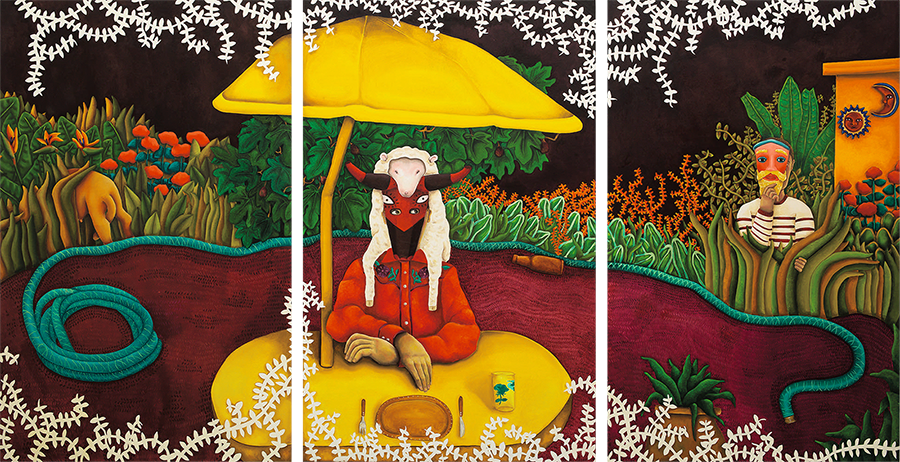
Por debajo de la mesa, a painting by María Fragoso Jara © The artist. Courtesy 1969 Gallery, New York City
The preliminary findings of the Freigeist Junior Research Group on the Dantean Anomaly, sponsored by Volkswagen, revealed a severe European drought during the transition from the High Medieval Climate Anomaly to the Little Ice Age. Weak upwelling in the Antarctic Ocean during the Last Glacial Period trapped more CO2, and subsea permafrost from the same era is thawing at an increasing rate. Global wind patterns may revert to those of five to ten thousand years ago. Seven hundred years of westerly winds in the Indian Ocean were encoded by Marion Island lake mud. Warming seas may be drowning starfish. The life spans of tropical trees will fall as forests’ average temperatures surpass 25ºC, and a gulf between the leaf-unfolding and flowering of European trees is widening. It was confirmed that mass terrestrial extinctions of animal species, like those of ocean extinctions, follow twenty-seven-million-year cycles, corresponding to periods of flood basalt volcanism and asteroid impacts, which may roughly align with cycles of Earth’s passage through the Milky Way.
During a dry month in the Maya Forest, a jaguar ate an ocelot. In the Red Sea, octopuses were punching fish, possibly as an expression of spite or of dominance. An American eel was tracked to the Sargasso Sea for the first time. Japanese labs linked the decline of unionid mussels to hybridization between native and introduced bitterling fish, and ecologists observed that polypropylene and polyethylene terephthalate are the plastics most commonly found in marine mussels. Oxygen and strontium levels in the bones of mummified baboons from the Ptolemaic and New Kingdom periods constrained the possible location of the lost land of Punt. DNA testing determined the West African origins of the forest elephants whose tusks sank in 1533 with the Bom Jesus. A rock mined 220 years ago in Cornwall was found to contain a previously unknown dark-green mineral, and geologists were listening for a change in the pitch of the Hochvogel.
Vietnamese honeybees, when offered a variety of feces with which to daub their hives to discourage raids by Vespa soror hornets, prefer that of chickens and pigs. Researchers worried that Canadian honeybees may not know how to use fecal defenses against invasive Asian giant hornets. The big-bellied glandular bush cricket appears frequently in the feces of Bubo bubo. Chinese scientists evaluated the testicular toxicity of cadmium in the Chinese fire-bellied newt. The cocoon of stroma surrounding pancreatic cancer cells can be compromised by a derivative of the thunder god vine. Researchers created an analogue of ibogaine that appears to be less toxic to zebrafish and may not cause serious hallucinations in humans, as suggested by a lack of head twitching in mice, who successfully reduced their alcohol consumption while on the drug. Synthetic llama antibodies can protect endangered cell proteins. “The situation is analogous to ugly fruit,” said one of the researchers. A new autonomous drone can use a live antenna taken from a hawk moth to navigate by smell. The use of honey to sweeten sheep’s-milk kefir makes Brazilian consumers feel less active, energetic, healthy, and loving. Fast walking in narrow corridors increases the risk of coronavirus transmission, whereas slower dental drilling reduces it. Frequent travel makes people happier by 7 percent.






















































































